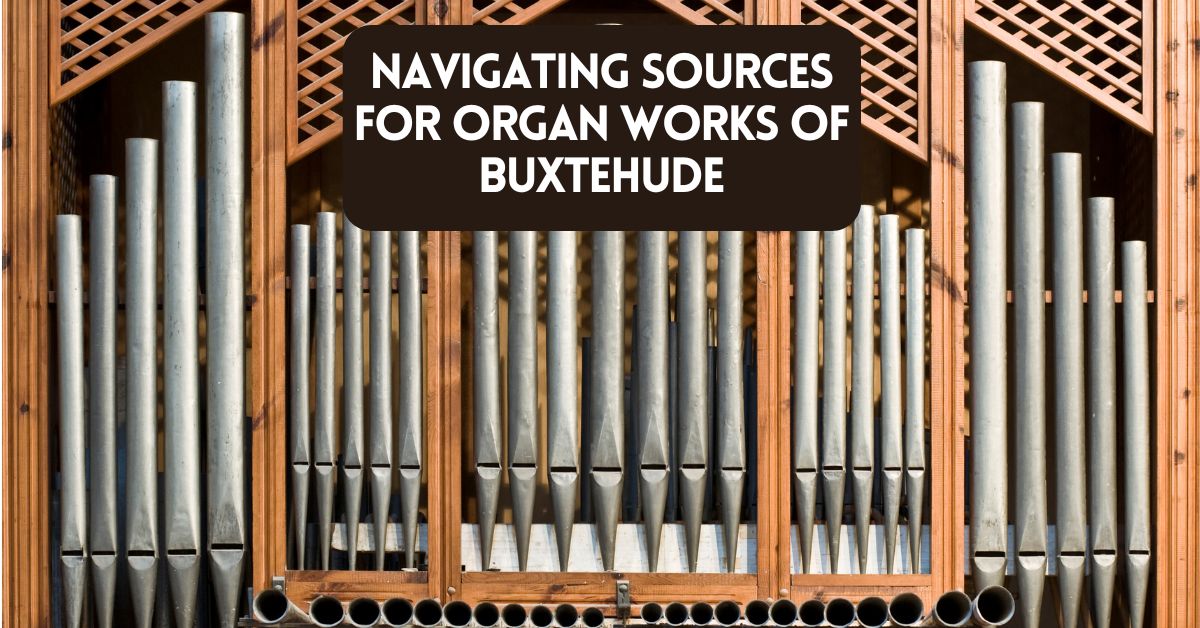When I prepare organ preludes for Sunday mornings at church, I have a soft spot for Baroque composers and their works. My go-to composers are Johann Sebastian Bach, Johann Pachelbel, and the North German organist Dieterich Buxtehude. In this post, we examine the issues organists face when choosing editions. Specifically, this post examines the issue of reliable sources for Buxtehude organ works.
In the world of music editing, particularly when dealing with older compositions, editors face significant challenges in determining the authoritativeness of sources. This issue is especially pronounced in Dieterich Buxtehude’s works, whose surviving organ compositions present a complex puzzle for both editors and performers.
Azure Hills Music contains affiliate links and is a member of the Amazon Services LLC Associates Program. As an Amazon Associate, we earn from qualifying purchases at no extra cost to you when you purchase using one of these Amazon links. Read our disclaimer and privacy policy for more information.

Hans-Jörg Gemeinholzer, CC BY 3.0 https://creativecommons.org/licenses/by/3.0, via Wikimedia Commons
Reliable sources for Buxtehude organ works
The Problem of Inconsistent Sources
Buxtehude’s organ works are an excellent example of the difficulties editors encounter. The surviving sources are often inconsistent, with multiple copies of the same work showing significant variations. This inconsistency stems from the historical context in which these works were copied and transmitted. Unlike modern practices that strive for precise replication, the scribal tradition of Buxtehude’s time allowed for a high degree of license. Copyists often made alterations to suit their own performance styles, leading to variations that complicate the task of identifying an authoritative version.
The Evolving View of Musical Texts
Traditionally, music works were viewed as stable artifacts, with each copy expected to replicate the composer’s original intentions faithfully. However, recent trends in textual criticism have shifted this perspective. Instead of seeing works as fixed entities, scholars now view them as dynamic processes, continuously shaped and reshaped by various hands over time. This view acknowledges that each surviving text, whether a holograph or a later copy, offers a unique glimpse into the work’s evolution.
Implications for Performers
For modern performers, this fluidity presents its own set of challenges. Without access to a definitive, authoritative source, performers must navigate a landscape of varied texts, offering different insights into the original work. This situation requires performers to engage more deeply with the sources, making informed choices about interpreting the music.
Buxtehude’s Tradition of Performance
Buxtehude’s keyboard music, rooted in a performance tradition, highlights the interplay between composition and improvisation. Many of his organ works were likely conceived with an improvisational spirit, reflecting his performances’ spontaneous and virtuosic nature. This tradition did not prioritize textual stability; instead, it valued the personal expression of each performer. As a result, performances of the same piece could differ significantly, adding another layer of complexity for both editors and performers.
The Role of Modern Editors
Modern editors play a crucial role in bridging the gap between historical sources and contemporary performance practice. Providing critical reconstructions of extant sources empowers performers to engage with the music more actively. Performers can compare different versions, make their own editorial decisions, and ultimately bring unique interpretations to the music.
Editions and Sources for Buxtehude Organ Works
Several editions of Dieterich Buxtehude’s organ works are available, each offering unique insights and editorial approaches:
- New Edition of the Complete Organ Works (Bärenreiter): This edition is highly reliable and thorough, aiming to present Buxtehude’s works with scholarly accuracy. It includes critical reports detailing editorial decisions. It’s my favorite edition and the one I typically choose to bring to church with me on Sunday mornings.
- Organ Works (Dover Music for Organ): An affordable edition to sample the organ works of Buxtehude, is the edition from Dover. This volume presents virtually all of the composer’s organ works — 78 toccatas, preludes, chorale variations, chorale fantasias, chorale preludes, fugues, canzonettas, chaconnes, and other works — reprinted directly from the definitive Breitkopf & Härtel edition by Philipp Spitta and Max Seiffert.
- Works by Buxtehude (IMSLP): On the IMSLP website, you can find free versions of many works from the composer. These also make it easier to compare various historical editions. An annual subscription to IMSLP is a very worthwhile investment.
These editions provide valuable resources for editors and performers seeking to understand and interpret Buxtehude’s organ music.
Conclusion
The challenges of editing and performing Buxtehude’s organ works underscore the broader difficulties faced in historical musicology. The lack of authoritative sources and the tradition of scribal license requires a nuanced approach that balances respect for historical practices with the needs of modern performers. By embracing the dynamic and collaborative nature of these works, both editors and performers can ensure that Buxtehude’s music continues to be experienced in all its richness and diversity.

